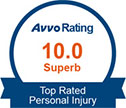When people are ejected from vehicles during accidents, it is common for serious injuries or even fatalities to occur. To better prepare motorists for this unique danger, this post discusses four critical things to know about vehicle ejections.
Ejection Accidents Have Devastating Consequences
People who are ejected from vehicles commonly experience serious injuries like bone fractures, internal organ damage, soft tissue injuries, spinal cord injuries, and traumatic brain injuries. Based on data compiled by the Insurance Information Institute (III), in 2017, approximately 83% of motor vehicle occupants who were ejected from vehicles were killed in the collision.
Common Causes of Ejection Accidents
The good news about ejection accidents is that many of them are preventable. Some of the most common causes of ejection accidents include:
- Rollovers, which pose a high risk of motorists being ejected from a vehicle.
- Failure to wear a seatbelt. One of the most helpful steps that a person can take to reduce the risk of being thrown from a vehicle is wearing a seatbelt.
- Certain vehicles carry a higher risk of ejection when a collision occurs. Many people assume that the larger sports utility vehicles are generally safer to drive, but these vehicles pose certain unique risks. Due to their large size and high center of gravity, sports utility vehicles are actually more likely to eject motorists.
There are Two Types of Ejections
There are two types of ejections that can occur in a collision — complete and partial ejections. In complete ejections, the motorist is fully thrown from the vehicle. These accidents cause the most devastating injuries based on how the motorist is thrown and the surface on which the motorist lands. In partial accidents, a motorist’s body might be thrown through a windshield or out of a passenger window. These ejections commonly occur when defective seat belts hold a person’s body inside a vehicle.
What You can do to Prevent Vehicle Ejections
There are some specific things that motorists can do to reduce the risk of being involved in an ejection accident. Some of these safety strategies include:
- Follow the speed limit and avoid speeding. To reduce the urge to speed, you should always leave for your destination with plenty of time to avoid rushing.
- If you have child safety seats in your vehicle, inspect them regularly to make sure that they are properly installed.
- Make sure your vehicle is adequately maintained, which includes monitoring the vehicle’s seat belts, windows, and doors.
- Never begin driving your vehicle until first making sure that you and any other passengers are all wearing seat belts.
Sometimes the vehicles themselves are defective, which may be the reason an ejection occurs. An experienced personal injury attorney will always investigate a vehicle ejection to determine if any vehicle defects were involved.
Speak with a Knowledgeable Car Accident Attorney
Vehicle ejections are dangerous, which is why it is a good idea to promptly retain the assistance of an accident lawyer if you have been injured in one of these accidents. An attorney at House Law LLC can help fight for the results you deserve. Contact our law office today to schedule a free case evaluation.
Tags: auto accident
Related Posts: Missouri & Kansas Weather-Related Car Crashes Understanding Liability After Vehicular Crashes Caused by the Rain Driving Safely in Construction Zones




